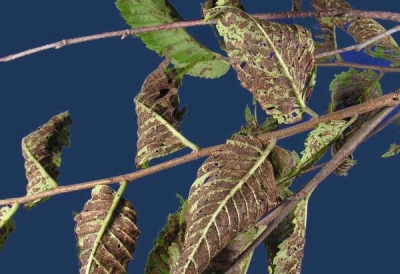Whoever named the elm leaf beetle isn’t likely to win any prizes for creativity. The insects are named after their favorite food: elm tree leaves. But trees aren’t the only place you might find an infestation. Beetles often find their way into homes through cracks to overwinter and make themselves known during warm periods, crawling on windows and other indoor surfaces.
Favorite outdoor overwinter locations include woodpiles and collected debris. Because the insects enter a sort of hibernation during the cold
When elm leaves begin to sprout, the beetles become active and fly to their feeding ground (the nearest elm) and dig in. Over the course of several weeks, females lay neat rows of yellow football-shaped eggs that are often mistaken for a dormant caterpillar. As they mature, the larvae also feed on leaves.
Larvae go through three stages of growing and shedding their skins and eat during all three until they are fully-grown a few weeks later. The next maturation stage is pupation, which usually takes place at the tree base, but pupae can also be found in bark folds. In just one or two weeks an adult elm leaf beetle emerges from the pupae and begins feeding. Midsummer will see a second generation and in warmer areas, a third generation may occur.
Since elm beetles spend much of their life feeding, an infested tree is almost guaranteed to sustain visible disfiguration that includes brown leaves and dead branches. Wind and heavy rain can exacerbate the damage done by insects and repeated injury can weaken a tree.
If you need help with elm leaf beetles, contact SprayTech, Colorado weed and tree spraying specialists, at 720-248-0000.
Comments are closed.